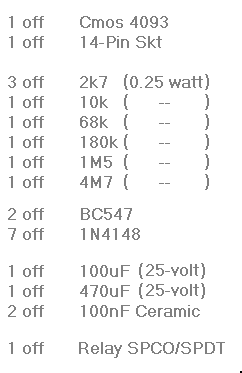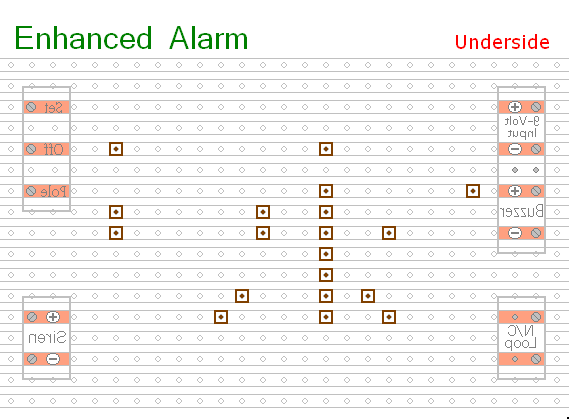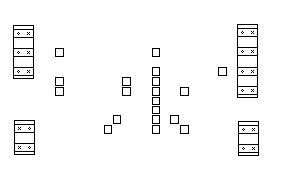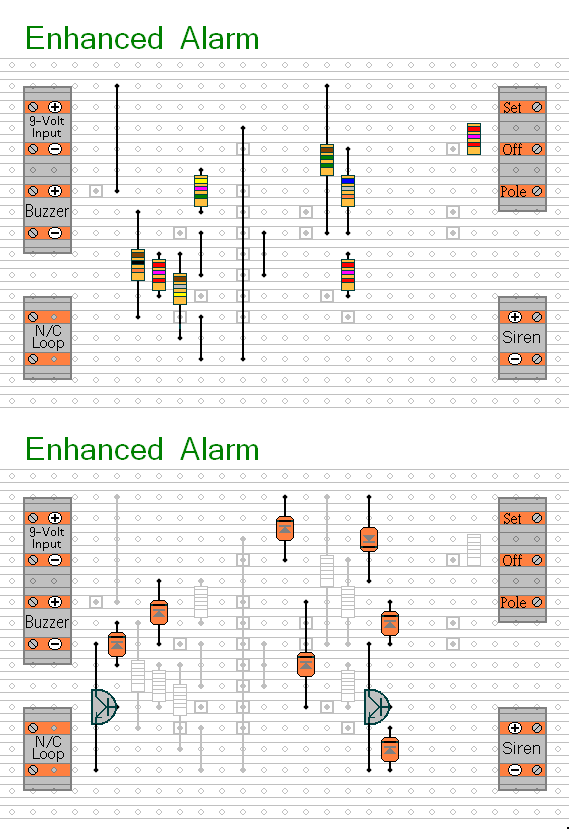| Use this DIY Alarm in your home - small business premises - shed - garage - lock-up etc. It can be battery powered and it has provision for normally-closed input devices such as - Magnetic-Reed Contacts, Foil Tape, Movement Detectors, PIRs etc. |
|---|
Learn More About The Cmos 4011 And 4093
Parts List
|
|---|

|
|
|---|
|
Construction Guide
Click here if you're new to constructing stripboard projects.
The terminals are a good set of reference points. To fit them, you may need to enlarge the holes slightly. Then turn the board over and use a felt-tip pen to mark the 19 places where the tracks are to be cut. Before you cut the tracks, use the "actual size" drawing to Check That The Pattern is Correctly Marked .
When you're satisfied that the pattern is right - cut the tracks. Make sure that the copper is cut all the way through. Sometimes a small strand of copper remains at the side of the cut and this will cause malfunction. Use a magnifying glass - and backlight the board. It only takes the smallest strand of copper to cause a problem. If you don't have the proper track-cutting tool, then a 6 to 8mm drill-bit will do. Just use the drill-bit as a hand tool - there's no need for a drilling machine.

Actual Size Of Pattern

Next fit the 8 resistors and the Five Wire Links. For the links - I used bare copper wire on the component side of the board. Telephone cable is suitable; the single stranded variety used indoors to wire telephone sockets. Stretching the core slightly will straighten it; and also allow the insulation to slip off.
The resistors and diodes are all shown lying flat on the board. However, those connected between close or adjacent tracks are mounted standing upright.
See The Photograph Of The Prototype.

The next stage is to fit the diodes and transistors. Pay particular attention to the orientation of the diodes. Note that one diode - D3 - is pointing down.
Fit the remaining six components (capacitors, relay and IC socket), Using a socket reduces the chances of damaging the IC - and makes it easier to replace if necessary.

Turn the board over and examine the underside carefully - to make sure that there are no unwanted solder bridges or other connections between the tracks. If you backlight the board during the examination - it makes potential problem areas easier to spot. When you're satisfied that everything is in order - add the 9 solder bridges.
Finish off by inserting the Cmos 4093 into the socket. Pin 1 of the IC should be in the top left-hand corner. Check that all 14 pins have entered the socket. Sometimes - instead of entering the socket - a pin will curl up under the IC.
You're Now Ready To Test Your Circuit
External Connections

Test Your Finished Circuit Board
 SUGGESTIONS
SUGGESTIONS
 SUGGESTIONS
SUGGESTIONS




